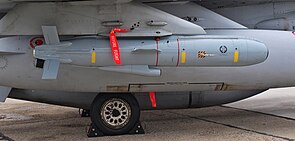Delilah (cruise missile)
| Delilah (cruise missile) | |
|---|---|
| General Information | |
| Type | Cruise missiles |
| Country of origin |
|
| Manufacturer | Israel Military Industries |
| Commissioning | 1995 |
| Unit price | $ 120,000 |
| Technical specifications | |
| length | 2710 mm |
| Combat weight | 187 kg |
| span | 1150 mm |
| drive | Turbojet BS-175 |
| speed | 250-300 m / s |
| Range | 250 km |
| Furnishing | |
| steering | GPS / INS / 2-way data link |
| Target location | IIR / CCD |
| Warhead | 30 kg |
| Detonator | programmable detonator |
| Weapon platforms | Airplanes , helicopters, ships , vehicles |
| Lists on the subject | |
The Delilah is a medium-range cruise missile . It is produced by the Israeli company Israel Military Industries .
development
Development at what was then TAAS began in the 1980s. The design is based on the MQM-74 Chukar - target drone . At first, Delilah was designed as an anti-radar drone . This should fly into enemy territory, locate radar systems there and destroy them. This drone was introduced by the Israel Defense Forces in the late 1980s under the name STAR-1 . Based on this concept, the Delilah cruise missile was later created. This was introduced by the Israeli armed forces in 1995. IMI is also working on a version of the Delilah for use on submarines . This version should have a range of 300 to 400 km. Furthermore, they are working with China on an airborne cruise missile based on the Delilah.
technology
Delilah can be used against ships, vehicles, and buildings. It can be used from airplanes, helicopters, ships and vehicles. Except when taking off from an aircraft, the cruise missile is accelerated by a solid fuel booster. After the booster has burned out, it is thrown off and the turbojet march engine ignites. The flight to the destination can take place in contour flight or at a maximum altitude of 9144 m. A precision ( CEP ) of around 1 m is achieved.
Delilah primarily navigates with her GPS / INS system. A FLIR sensor is used for the final approach . A 2-way data link transmits a TV image to the surgeon, with the help of which the surgeon can aim at targets (man-in-the-loop). This also makes it possible to combat moving targets (up to 50 km / h). If the target is not discovered by the operator, the cruise missile can circle over the target area for a longer period of time and the operator can try to identify the actual target or fight other targets. The maximum flight time is 22 minutes.
Delilah can also be used autonomously against preprogrammed targets. A large number of waypoints can be defined for operational and flight planning. If necessary, the guided missile can also be reprogrammed after launch using the 2-way data link.
The warhead consists of an armor-piercing charge with a fragmentation jacket. The detonator can be set to different operating modes (impact detonator or delay detonator) in order to be able to effectively combat surface targets as well as bunkered and armored objects.
variants
- Delilah-AL: For the use of airplanes.
- Delilah-HL: For the use of helicopters.
- Delilah-SL: Variant with folding wings for the use of ships.
- Delilah-GL: variant with folding wings for the use of vehicles.
commitment
The first use of Delilah took place in 2006. An unknown number Delilah were F-16D of the IAF against targets in Lebanon used. On May 9, 2018, several Delilah were used against targets in Syria . In addition to Syrian and Iranian military installations, the cruise missiles also destroyed S-75 , S-200 , Buk-M2 and Panzir-S1 anti-aircraft systems.
Users
literature
- Thomas Newdick: Postwar Air Weapons 1945 - Present. 2011, ISBN 978-1-907446-59-7 .
- Jane's Naval Weapon Systems 2004-2005. ISBN 0-7106-0893-4 .
Web links
- Delilah-AL at IMI (English)
- Delilah-HL at IMI (English)
- Delilah-GL at IMI (English)
- Delilah-AL and Delilah-HL at Janes.com (English)
Individual evidence
- ↑ a b Janes.com , accessed November 30, 2011 (English)
- ^ Phillip E. Pace: Detecting and Classifying Low Probability of Intercept Radar. Artech House Publishers, 2003. pp. 603-604.
- ↑ Strategycenter.com , accessed November 30, 2011 (English)
- ↑ Thomas Newdick: Postwar Air Weapons 1945 - Present. 2011, p. 89.
- ↑ Defencetalk.com , accessed November 30, 2011 (English)
- ↑ David Cenciotti: The Israeli Air Force Has Just Released A Video Of A Pantsir-S1 Air Defense System Being Struck In Last Night's Attack In Syria. In: theaviationist.com. May 11, 2018, accessed May 11, 2018 .
- ↑ Panzir-S "destroyed" by Israel can be repaired
